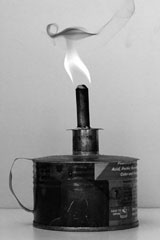Kerosene lamps spew black carbon, should be replaced, UC Berkeley-Illinois study says.
 The primary source of light for more than a billion people in developing nations is also churning out black carbon at levels previously overlooked in greenhouse gas estimates, according to a new study led by researchers at UC Berkeley and the University of Illinois.
The primary source of light for more than a billion people in developing nations is also churning out black carbon at levels previously overlooked in greenhouse gas estimates, according to a new study led by researchers at UC Berkeley and the University of Illinois.
Results from field and lab tests found that 7 to 9 percent of the kerosene in wick lamps — used for light in 250-300 million households without electricity — is converted to black carbon when burned. In comparison, only half of 1 percent of the emissions from burning wood is converted to black carbon.
Factoring in the new study results leads to a twentyfold increase in estimates of black carbon emissions from kerosene-fueled lighting. The previous estimates come from established databases used by the Intergovernmental Panel on Climate Change and others. One kilogram of black carbon, a byproduct of incomplete combustion and an important greenhouse gas, produces as much warming in a month as 700 kilograms of carbon dioxide does over 100 years, the authors said.
“The orange glow in flames comes from black carbon, so the brighter the glow, the more black carbon is being made,” said study principal investigator Tami Bond, associate professor of civil and environmental engineering at the University of Illinois at Urbana-Champaign. “If it’s not burned away, it goes into the atmosphere.”
The findings, published online this month in the journal Environmental Science & Technology, are coming out at the same time that the United Nations Climate Change Conference kicks off in Doha, Qatar. While officials from around the world are seeking effective policies and guidelines for cutting greenhouse gas emissions, the study authors note that the simple act of replacing kerosene lamps could pack a wallop toward that effort.
“There are no magic bullets that will solve all of our greenhouse gas problems, but replacing kerosene lamps is low-hanging fruit, and we don’t have many examples of that in the climate world,” said study co-author Kirk Smith, professor at UC Berkeley’s School of Public Health and director of the Global Health and Environment Program. “There are many inexpensive, cleaner alternatives to kerosene lamps that are available now, and few if any barriers to switching to them.”
Smith pointed to lanterns with light-emitting diodes that can be powered by solar cells or even advanced cookstoves that generate electricity from the heat produced. Such technology, said Smith, is already available in developing countries.

Recent Comments